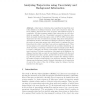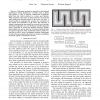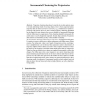SSD
2009
Springer
13 years 11 months ago
2009
Springer
A key issue in clustering data, regardless the algorithm used, is the definition of a distance function. In the case of trajectory data, different distance functions have been pro...
IROS
2009
IEEE
13 years 11 months ago
2009
IEEE
— This paper presents an approach to time-optimal kinodynamic motion planning for a mobile robot. A global path planner is used to generate collision-free straight-line paths fro...
ICRA
2009
IEEE
13 years 11 months ago
2009
IEEE
— This paper presents Tiji, a trajectory generation scheme, ie an algorithm that computes a feasible trajectory between a start and a goal state, for a given robotic system. Tiji...
AVSS
2009
IEEE
13 years 11 months ago
2009
IEEE
We present a novel unsupervised inter-camera trajectory correspondence algorithm that does not require prior knowledge of the camera placement. The approach consists of three step...
DASFAA
2010
IEEE
13 years 11 months ago
2010
IEEE
Trajectory clustering has played a crucial role in data analysis since it reveals underlying trends of moving objects. Due to their sequential nature, trajectory data are often rec...



